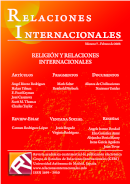New Barbarians, Old Barbarians: Post-Cold War IR Theory "Everything Old Is New Again", en Barbarians and Civilization in Internacional Relations, Pluto Press, Londres, 2002
Keywords:
International Relations, new world order, “two worlds thesis”, Imperialism, 19th century Standard of CivilizationCopyright (c) 2008 Mark SALTER

This work is licensed under a Creative Commons Attribution-NonCommercial-NoDerivatives 4.0 International License.
Abstract
The end of the Cold War and the allegedly new world order have led to the emergence of new explanatory paradigms in international relations. Among them, the so called “thesis of the two worlds” has achieved a prominent position. This paradigm highlights the global dualism between “centre and periphery”, “areas of peace and areas of conflict”, “the West and the rest”. In this chapter, extracted from the work Barbarians and Civilization in International Relations (2002), Mark Salter advocates for an analysis that takes on board a historical perspective of the nature and scope of the reintroduction of the 19th century imperialistic stereotype of the European dichotomy between the barbarians and civilized peoples into IR Theory. Consequently, Salter makes a thorough review of the explanations offered by theorists such as S. P. Huntington, P. Kennedy, R. Kaplan or B. Barber in order to contend that “everything new is old again”.





